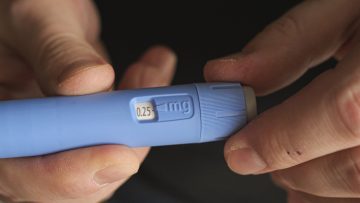NEW STUDY. GLP1 medicines work best for those diabetes patients who have a reduced production of insulin. The study from the University of Gothenburg shows that it is possible to personalize the treatment of type 2 diabetes.
This is the first clinical study to systematically test whether personalizing medical treatment of type 2 diabetes can work, and how such personalization could work in the healthcare practice. The results of the study are published in the journal Nature Metabolism.
The study used the two most cutting-edge diabetes medicines, GLP1 medicines and SGLT2 inhibitors. The study recruited 239 participants from two different subgroups of type 2 diabetes. The results show that GLP1 medicines are significantly more effective in patients where the underlying disease mechanism is impaired insulin production. For patients with lower BMI and high insulin production, the SGLT2 inhibitor worked well, but for 30% of the patients in the study, SGLT2 inhibitors were found to have no effect at all.
Low insulin production or high resistance

The work has been led by Anders Rosengren, a professor at the Institute of Neuroscience and Physiology, who is also affiliated with the Wallenberg Centre for Molecular and Translational Medicine (WCMTM) at the University of Gothenburg.
“The two medicinal products have different mechanisms of action, and there is a wide variation in how patients respond to them. Therefore, there may be an advantage in personalizing the treatment, but so far there have been no randomized studies in this area,” says Anders Rosengren.
“We started from a recent discovery in a Swedish collaboration, where we showed that type 2 diabetes can be divided into several subgroups, based on different disease characteristics and risks of complications. The two subgroups included in the study are the two most severe, where one has low insulin production and the other has good insulin production but high insulin resistance,” says Anders Rosengren.
Tailored treatment
In the study, patients were randomly assigned to one of two diabetes groups, with half receiving GLP1 medicines and the other half receiving SGLT2 inhibitors.
“In total, we had four different study groups with over fifty diabetic patients in each group. They were randomized to one of the medicines for six months, and we followed the effect on their long-term blood sugar,” says Anders Rosengren and continues:
“Since the group with low insulin production had a significantly better response to GLP1 medicines compared to those whose disease is due to high insulin resistance, this opens up the possibility of tailoring treatment according to the patient’s subgroup.”
Several factors come into play

However, sorting patients into subgroups can be too rigid a tool, according to Anders Rosengren. The study shows that the personalization of diabetes treatment can be even more effective by considering data on insulin secretion, insulin resistance, blood pressure and weight for each patient.
“Today, doctors try to find the treatment that works best for the patient, but this presents an opportunity to provide the most effective treatment adapted to the individual disease situation right from the start,” says Anders Rosengren.
Improperly treated diabetes can increase the risk of several serious complications, especially for certain subgroups. “The relatively inexpensive C-peptide test could help doctors determine more precisely which medicine a patient should receive for best effect,” says Anders Rosengren:
“It is a simple fasting test for insulin production that is already available in healthcare centers. It would not be difficult to introduce it into clinical practice, providing a valuable tool to improve the clinical management of patients.”
Title: Dwibedi C et al., Randomized open-label trial of semaglutide and dapagliflozin in patients with type 2 diabetes of different pathophysiology; Nature Metabolism 2024; https://doi.org/10.1038/s42255-023-00943-3.
BY: ELIN LINDSTRÖM











